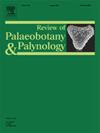A sedimentary record of fire evolution history and its response to climate change and human activities during the last 7000 years from Lake Qionghai, southeastern Tibetan Plateau
IF 1.7
3区 地球科学
Q2 PALEONTOLOGY
引用次数: 0
Abstract
The occurrence of fire is related to climate, vegetation, and human activity. The Qionghai Lake catchment, situated on the southeastern margin of the Tibetan Plateau, exhibits well-developed vegetation and a high fire frequency and is located in Xichang City—a settlement with a long-standing historical legacy. It is therefore one of the most suitable areas to study the fire-climate-vegetation-human connection. In this study, we reconstruct the fire evolution history of Lake Qionghai over the last 7000 years using AMS 14C dating, along with an analysis of charcoal accumulation rate (CHAR) and major pollen taxa. Our results reveal two distinct phases in Holocene fire dynamics: (1) During the period of 7000–620 cal yr BP, fire activity exhibited a sustained decrease, which may have been linked to the reduction in lightning due to the temperature drop during that period. (2) From 620 cal yr BP to the present, a marked increase in fire activity has been accompanied by a pronounced decline in woody plants, coinciding with the proliferation of anthropophilic plant—Poaceae. We propose that the increased fire activity in the catchment area has become increasingly influenced by human activities, particularly through population growth, settlement expansion, and the adoption of slash-and-burn agricultural practices that collectively intensified fire regime.
青藏高原东南部琼海近7000年火的沉积记录及其对气候变化和人类活动的响应
火灾的发生与气候、植被和人类活动有关。琼海流域位于青藏高原东南边缘,植被发达,火灾频发,地处历史悠久的西昌市。因此,这里是研究火-气候-植被-人类关系最适宜的地区之一。本研究利用AMS 14C测年技术重建了琼海湖区近7000年的火灾演化史,并对炭积累速率(CHAR)和主要花粉类群进行了分析。研究结果揭示了全新世火灾动态的两个不同阶段:(1)在7000-620 cal yr BP期间,火灾活动呈现持续减少的趋势,这可能与该时期气温下降导致闪电减少有关。(2)从620 cal yr BP至今,森林火灾活动的显著增加伴随着木本植物的显著减少,与亲人植物——禾科的大量繁殖相一致。我们认为,汇水区火灾活动的增加受到人类活动的影响越来越大,特别是人口增长、定居点扩张和采用刀耕火种的农业做法,这些都加剧了火灾的发生。
本文章由计算机程序翻译,如有差异,请以英文原文为准。
求助全文
约1分钟内获得全文
求助全文
来源期刊
CiteScore
3.50
自引率
21.10%
发文量
149
审稿时长
6 months
期刊介绍:
The Review of Palaeobotany and Palynology is an international journal for articles in all fields of palaeobotany and palynology dealing with all groups, ranging from marine palynomorphs to higher land plants. Original contributions and comprehensive review papers should appeal to an international audience. Typical topics include but are not restricted to systematics, evolution, palaeobiology, palaeoecology, biostratigraphy, biochronology, palaeoclimatology, paleogeography, taphonomy, palaeoenvironmental reconstructions, vegetation history, and practical applications of palaeobotany and palynology, e.g. in coal and petroleum geology and archaeology. The journal especially encourages the publication of articles in which palaeobotany and palynology are applied for solving fundamental geological and biological problems as well as innovative and interdisciplinary approaches.

 求助内容:
求助内容: 应助结果提醒方式:
应助结果提醒方式:


